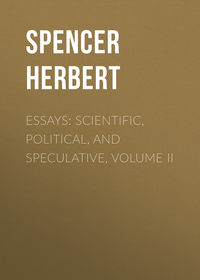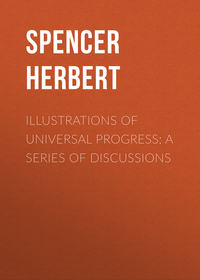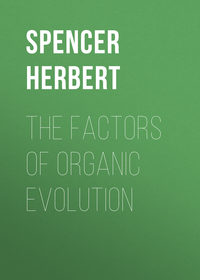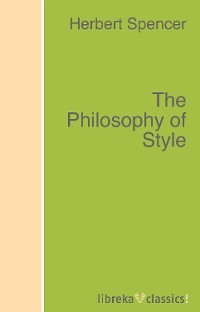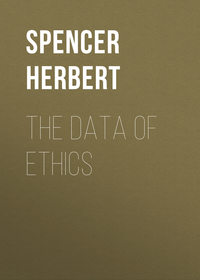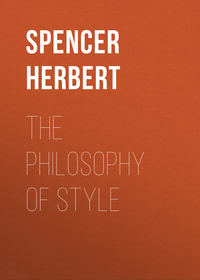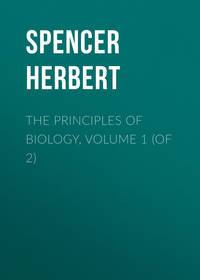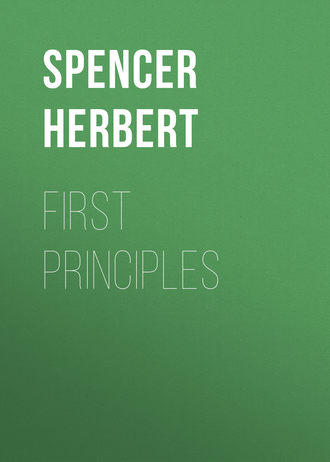 полная версия
полная версияFirst Principles
Already in the foregoing pages the method of seeking such a reconciliation has been vaguely foreshadowed. Before proceeding further, however, it will be well to treat the question of method more definitely. To find that truth in which Religion and Science coalesce, we must know in what direction to look for it, and what kind of truth it is likely to be.
§ 7. We have found à priori reason for believing that in all religions, even the rudest, there lies hidden a fundamental verity. We have inferred that this fundamental verity is that element common to all religions, which remains after their discordant peculiarities have been mutually cancelled. And we have further inferred that this element is almost certain to be more abstract than any current religious doctrine. Now it is manifest that only in some highly abstract proposition, can Religion and Science find a common ground. Neither such dogmas as those of the trinitarian and unitarian, nor any such idea as that of propitiation, common though it may be to all religions, can serve as the desired basis of agreement; for Science cannot recognize beliefs like these: they lie beyond its sphere. Hence we see not only that, judging by analogy, the essential truth contained in Religion is that most abstract element pervading all its forms; but also that this most abstract element is the only one in which Religion is likely to agree with Science.
Similarly if we begin at the other end, and inquire what scientific truth can unite Science and Religion. It is at once manifest that Religion can take no cognizance of special scientific doctrines; any more than Science can take cognizance of special religious doctrines. The truth which Science asserts and Religion indorses cannot be one furnished by mathematics; nor can it be a physical truth; nor can it be a truth in chemistry: it cannot be a truth belonging to any particular science. No generalization of the phenomena of space, of time, of matter, or of force, can become a Religious conception. Such a conception, if it anywhere exists in Science, must be more general than any of these – must be one underlying all of them. If there be a fact which Science recognizes in common with Religion, it must be that fact from which the several branches of Science diverge, as from their common root.
Assuming then, that since these two great realities are constituents of the same mind, and respond to different aspects of the same Universe, there must be a fundamental harmony between them; we see good reason to conclude that the most abstract truth contained in Religion and the most abstract truth contained in Science must be the one in which the two coalesce. The largest fact to be found within our mental range must be the one of which we are in search. Uniting these positive and negative poles of human thought, it must be the ultimate fact in our intelligence.
§ 8. Before proceeding in the search for this common datum let me bespeak a little patience. The next three chapters, setting out from different points and converging to the same conclusion, will be comparatively unattractive. Students of philosophy will find in them much that is more or less familiar; and to most of those who are unacquainted with the literature of modern metaphysics, they may prove somewhat difficult to follow.
Our argument however cannot dispense with these chapters; and the greatness of the question at issue justifies even a heavier tax on the reader’s attention. The matter is one which concerns each and all of us more than any other matter whatever. Though it affects us little in a direct way, the view we arrive at must indirectly affect us in all our relations – must determine our conception of the Universe, of Life, of Human Nature – must influence our ideas of right and wrong, and so modify our conduct. To reach that point of view from which the seeming discordance of Religion and Science disappears, and the two merge into one, must cause a revolution of thought fruitful in beneficial consequences, and must surely be worth an effort.
Here ending preliminaries, let us now address ourselves to this all-important inquiry.
CHAPTER II.
ULTIMATE RELIGIOUS IDEAS
§ 9. When, on the sea-shore, we note how the hulls of distant vessels are hidden below the horizon, and how, of still remoter vessels, only the uppermost sails are visible, we realize with tolerable clearness the slight curvature of that portion of the sea’s surface which lies before us. But when we seek in imagination to follow out this curved surface as it actually exists, slowly bending round until all its meridians meet in a point eight thousand miles below our feet, we find ourselves utterly baffled. We cannot conceive in its real form and magnitude even that small segment of our globe which extends a hundred miles on every side of us; much less the globe as a whole. The piece of rock on which we stand can be mentally represented with something like completeness: we find ourselves able to think of its top, its sides, and its under surface at the same time; or so nearly at the same time that they seem all present in consciousness together; and so we can form what we call a conception of the rock. But to do the like with the Earth we find impossible. If even to imagine the antipodes as at that distant place in space which it actually occupies, is beyond our power; much more beyond our power must it be at the same time to imagine all other remote points on the Earth’s surface as in their actual places. Yet we habitually speak as though we had an idea of the Earth – as though we could think of it in the same way that we think of minor objects.
What conception, then, do we form of it? the reader may ask. That its name calls up in us some state of consciousness is unquestionable; and if this state of consciousness is not a conception, properly so called, what is it? The answer seems to be this: – We have learnt by indirect methods that the Earth is a sphere; we have formed models approximately representing its shape and the distribution of its parts; generally when the Earth is referred to, we either think of an indefinitely extended mass beneath our feet, or else, leaving out the actual Earth, we think of a body like a terrestrial globe; but when we seek to imagine the Earth as it really is, we join these two ideas as well as we can – such perception as our eyes give us of the Earth’s surface we couple with the conception of a sphere. And thus we form of the Earth, not a conception properly so called, but only a symbolic conception.6
A large proportion of our conceptions, including all those of much generality, are of this order. Great magnitudes, great durations, great numbers, are none of them actually conceived, but are all of them conceived more or less symbolically; and so, too, are all those classes of objects of which we predicate some common fact. When mention is made of any individual man, a tolerably complete idea of him is formed. If the family he belongs to be spoken of, probably but a part of it will be represented in thought: under the necessity of attending to that which is said about the family, we realize in imagination only its most important or familiar members, and pass over the rest with a nascent consciousness which we know could, if requisite, be made complete. Should something be remarked of the class, say farmers, to which this family belongs, we neither enumerate in thought all the individuals contained in the class, nor believe that we could do so if required; but we are content with taking some few samples of it, and remembering that these could be indefinitely multiplied. Supposing the subject of which something is predicated be Englishmen, the answering state of consciousness is a still more inadequate representative of the reality. Yet more remote is the likeness of the thought to the thing, if reference be made to Europeans or to human beings. And when we come to propositions concerning the mammalia, or concerning the whole of the vertebrata, or concerning animals in general, or concerning all organic beings, the unlikeness of our conceptions to the objects named reaches its extreme. Throughout which series of instances we see, that as the number of objects grouped together in thought increases, the concept, formed of a few typical samples joined with the notion of multiplicity, becomes more and more a mere symbol; not only because it gradually ceases to represent the size of the group, but also because as the group grows more heterogeneous, the typical samples thought of are less like the average objects which the group contains.
This formation of symbolic conceptions, which inevitably arises as we pass from small and concrete objects to large and to discrete ones, is mostly a very useful, and indeed necessary, process. When, instead of things whose attributes can be tolerably well united in a single state of consciousness, we have to deal with things whose attributes are too vast or numerous to be so united, we must either drop in thought part of their attributes, or else not think of them at all – either form a more or less symbolic conception, or no conception. We must predicate nothing of objects too great or too multitudinous to be mentally represented; or we must make our predications by the help of extremely inadequate representations of such objects – mere symbols of them.
But while by this process alone we are enabled to form general propositions, and so to reach general conclusions, we are by this process perpetually led into danger, and very often into error. We habitually mistake our symbolic conceptions for real ones; and so are betrayed into countless false inferences. Not only is it that in proportion as the concept we form of any thing or class of things, misrepresents the reality, we are apt to be wrong in any assertion we make respecting the reality; but it is that we are led to suppose we have truly conceived a great variety of things which we have conceived only in this fictitious way; and further to confound with these certain things which cannot be conceived in any way. How almost unavoidably we fall into this error it will be needful here to observe.
From objects readily representable in their totality, to those of which we cannot form even an approximate representation, there is an insensible transition. Between a pebble and the entire Earth a series of magnitudes might be introduced, each of which differed from the adjacent ones so slightly that it would be impossible to say at what point in the series our conceptions of them became inadequate. Similarly, there is a gradual progression from those groups of a few individuals which we can think of as groups with tolerable completeness, to those larger and larger groups of which we can form nothing like true ideas. Whence it is manifest that we pass from actual conceptions to symbolic ones by infinitesimal steps. Note next that we are led to deal with our symbolic conceptions as though they were actual ones, not only because we cannot clearly separate the two, but also because, in the great majority of cases, the first serve our purposes nearly or quite as well as the last – are simply the abbreviated signs we substitute for those more elaborate signs which are our equivalents for real objects. Those very imperfect representations of ordinary things which we habitually make in thinking, we know can be developed into adequate ones if needful. Those concepts of larger magnitudes and more extensive classes which we cannot make adequate, we still find can be verified by some indirect process of measurement or enumeration. And even in the case of such an utterly inconceivable object as the Solar System, we yet, through the fulfilment of predictions founded on our symbolic conception of it, gain the conviction that this symbolic conception stands for an actual existence, and, in a sense, truly expresses certain of its constituent relations. Thus our symbolic conceptions being in the majority of cases capable of development into complete ones, and in most other cases serving as steps to conclusions which are proved valid by their correspondence with observation, we acquire a confirmed habit of dealing with them as true conceptions – as real representations of actualities. Learning by long experience that they can, if needful, be verified, we are led habitually to accept them without verification. And thus we open the door to some which profess to stand for known things, but which really stand for things that cannot be known in any way.
To sum up, we must say of conceptions in general, that they are complete only when the attributes of the object conceived are of such number and kind that they can be represented in consciousness so nearly at the same time as to seem all present together; that as the objects conceived become larger and more complex, some of the attributes first thought of fade from consciousness before the rest have been represented, and the conception thus becomes imperfect; that when the size, complexity, or discreteness of the object conceived becomes very great, only a small portion of its attributes can be thought of at once, and the conception formed of it thus becomes so inadequate as to be a mere symbol; that nevertheless such symbolic conceptions, which are indispensable in general thinking, are legitimate, provided that by some cumulative or indirect process of thought, or by the fulfilment of predictions based on them, we can assure ourselves that they stand for actualities; but that when our symbolic conceptions are such that no cumulative or indirect processes of thought can enable us to ascertain that there are corresponding actualities, nor any predictions be made whose fulfilment can prove this, then they are altogether vicious and illusive, and in no way distinguishable from pure fictions.
§ 10. And now to consider the bearings of this general truth on our immediate topic – Ultimate Religious Ideas.
To the aboriginal man and to every civilized child the problem of the Universe suggests itself. What is it? and whence comes it? are questions that press for solution, when, from time to time, the imagination rises above daily trivialities. To fill the vacuum of thought, any theory that is proposed seems better than none. And in the absence of others, any theory that is proposed easily gains a footing and afterwards maintains its ground: partly from the readiness of mankind to accept proximate explanations; partly from the authority which soon accumulates round such explanations when given.
A critical examination, however, will prove not only that no current hypothesis is tenable, but also that no tenable hypothesis can be framed.
§ 11. Respecting the origin of the Universe three verbally intelligible suppositions may be made. We may assert that it is self-existent; or that it is self-created; or that it is created by an external agency. Which of these suppositions is most credible it is not needful here to inquire. The deeper question, into which this finally merges, is, whether any one of them is even conceivable in the true sense of the word. Let us successively test them.
When we speak of a man as self-supporting, of an apparatus as self-acting, or of a tree as self-developed, our expressions, however inexact, stand for things that can be realized in thought with tolerable completeness. Our conception of the self-development of a tree is doubtless symbolic. But though we cannot really represent in consciousness the entire series of complex changes through which the tree passes, yet we can thus represent the leading features of the series; and general experience teaches us that by long continued observation we could gain the power to realize in thought a series of changes more fully representing the actual series: that is, we know that our symbolic conception of self-development can be expanded into something like a real conception; and that it expresses, however inaccurately, an actual process in nature. But when we speak of self-existence, and, helped by the above analogies, form some vague symbolic conception of it, we delude ourselves in supposing that this symbolic conception is of the same order as the others. On joining the word self to the word existence, the force of association makes us believe we have a thought like that suggested by the compound word self-acting. An endeavour to expand this symbolic conception, however, will undeceive us. In the first place, it is clear that by self-existence we especially mean, an existence independent of any other – not produced by any other: the assertion of self-existence is simply an indirect denial of creation. In thus excluding the idea of any antecedent cause, we necessarily exclude the idea of a beginning; for to admit the idea of a beginning – to admit that there was a time when the existence had not commenced – is to admit that its commencement was determined by something, or was caused; which is a contradiction. Self-existence, therefore, necessarily means existence without a beginning; and to form a conception of self-existence is to form a conception of existence without a beginning. Now by no mental effort can we do this. To conceive existence through infinite past-time, implies the conception of infinite past-time, which is an impossibility. To this let us add, that even were self-existence conceivable, it would not in any sense be an explanation of the Universe. No one will say that the existence of an object at the present moment is made easier to understand by the discovery that it existed an hour ago, or a day ago, or a year ago; and if its existence now is not made in the least degree more comprehensible by its existence during some previous finite period of time, then no accumulation of such finite periods, even could we extend them to an infinite period, would make it more comprehensible. Thus the Atheistic theory is not only absolutely unthinkable, but, even if it were thinkable, would not be a solution. The assertion that the Universe is self-existent does not really carry us a step beyond the cognition of its present existence; and so leaves us with a mere re-statement of the mystery.
The hypothesis of self-creation, which practically amounts to what is called Pantheism, is similarly incapable of being represented in thought. Certain phenomena, such as the precipitation of invisible vapour into cloud, aid us in forming a symbolic conception of a self-evolved Universe; and there are not wanting indications in the heavens, and on the earth, which help us to render this conception tolerably definite. But while the succession of phases through which the Universe has passed in reaching its present form, may perhaps be comprehended as in a sense self-determined; yet the impossibility of expanding our symbolic conception of self-creation into a real conception, remains as complete as ever. Really to conceive self-creation, is to conceive potential existence passing into actual existence by some inherent necessity; which we cannot do. We cannot form any idea of a potential existence of the universe, as distinguished from its actual existence. If represented in thought at all, potential existence must be represented as something, that is as an actual existence; to suppose that it can be represented as nothing, involves two absurdities – that nothing is more than a negation, and can be positively represented in thought; and that one nothing is distinguished from all other nothings by its power to develope into something. Nor is this all. We have no state of consciousness answering to the words – an inherent necessity by which potential existence became actual existence. To render them into thought, existence, having for an indefinite period remained in one form, must be conceived as passing without any external or additional impulse, into another form; and this involves the idea of a change without a cause – a thing of which no idea is possible. Thus the terms of this hypothesis do not stand for real thoughts; but merely suggest the vaguest symbols incapable of any interpretation. Moreover, even were it true that potential existence is conceivable as a different thing from actual existence; and that the transition from the one to the other can be mentally realized as a self-determined change; we should still be no forwarder: the problem would simply be removed a step back. For whence the potential existence? This would just as much require accounting for as actual existence; and just the same difficulties would meet us. Respecting the origin of such a latent power, no other suppositions could be made than those above named – self-existence, self-creation, creation by external agency. The self-existence of a potential universe is no more conceivable than we have found the self-existence of the actual universe to be. The self-creation of such a potential universe would involve over again the difficulties here stated – would imply behind this potential universe a more remote potentiality; and so on in an infinite series, leaving us at last no forwarder than at first. While to assign as the source of this potential universe an external agency, would be to introduce the notion of a potential universe for no purpose whatever.
There remains to be examined the commonly-received or theistic hypothesis – creation by external agency. Alike in the rudest creeds and in the cosmogony long current among ourselves, it is assumed that the genesis of the Heavens and the Earth is effected somewhat after the manner in which a workman shapes a piece of furniture. And this assumption is made not by theologians only, but by the immense majority of philosophers, past and present. Equally in the writings of Plato, and in those of not a few living men of science, we find it taken for granted that there is an analogy between the process of creation and the process of manufacture. Now in the first place, not only is this conception one that cannot by any cumulative process of thought, or the fulfilment of predictions based on it, be shown to answer to anything actual; and not only is it that in the absence of all evidence respecting the process of creation, we have no proof of correspondence even between this limited conception and some limited portion of the fact; but it is that the conception is not even consistent with itself – cannot be realized in thought, when all its assumptions are granted. Though it is true that the proceedings of a human artificer may vaguely symbolize to us a method after which the Universe might be shaped, yet they do not help us to comprehend the real mystery; namely, the origin of the material of which the Universe consists. The artizan does not make the iron, wood, or stone, he uses; but merely fashions and combines them. If we suppose suns, and planets, and satellites, and all they contain to have been similarly formed by a “Great Artificer,” we suppose merely that certain pre-existing elements were thus put into their present arrangement. But whence the pre-existing elements? The comparison helps us not in the least to understand that; and unless it helps us to understand that, it is worthless. The production of matter out of nothing is the real mystery, which neither this simile nor any other enables us to conceive; and a simile which does not enable us to conceive this, may just as well be dispensed with. Still more manifest does the insufficiency of this theory of creation become, when we turn from material objects to that which contains them – when instead of matter we contemplate space. Did there exist nothing but an immeasurable void, explanation would be needed as much as now. There would still arise the question – how came it so? If the theory of creation by external agency were an adequate one, it would supply an answer; and its answer would be – space was made in the same manner that matter was made. But the impossibility of conceiving this is so manifest, that no one dares to assert it. For if space was created, it must have been previously non-existent. The non-existence of space cannot, however, by any mental effort be imagined. It is one of the most familiar truths that the idea of space as surrounding us on all sides, is not for a moment to be got rid of – not only are we compelled to think of space as now everywhere present, but we are unable to conceive its absence either in the past or the future. And if the non-existence of space is absolutely inconceivable, then, necessarily, its creation is absolutely inconceivable. Lastly, even supposing that the genesis of the Universe could really be represented in thought as the result of an external agency, the mystery would be as great as ever; for there would still arise the question – how came there to be an external agency? To account for this only the same three hypotheses are possible – self-existence, self-creation, and creation by external agency. Of these the last is useless: it commits us to an infinite series of such agencies, and even then leaves us where we were. By the second we are practically involved in the same predicament; since, as already shown, self-creation implies an infinite series of potential existences. We are obliged therefore to fall back upon the first, which is the one commonly accepted and commonly supposed to be satisfactory. Those who cannot conceive a self-existent universe; and who therefore assume a creator as the source of the universe; take for granted that they can conceive a self-existent creator. The mystery which they recognize in this great fact surrounding them on every side, they transfer to an alleged source of this great fact; and then suppose that they have solved the mystery. But they delude themselves. As was proved at the outset of the argument, self-existence is rigorously inconceivable; and this holds true whatever be the nature of the object of which it is predicated. Whoever agrees that the atheistic hypothesis is untenable because it involves the impossible idea of self-existence, must perforce admit that the theistic hypothesis is untenable if it contains the same impossible idea.


